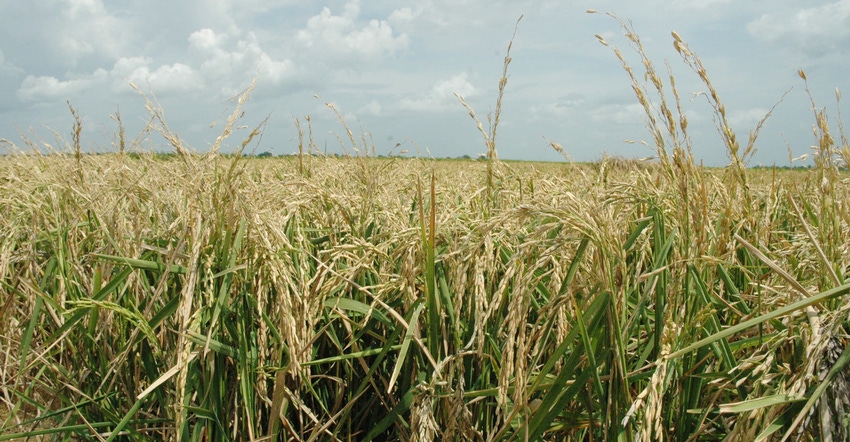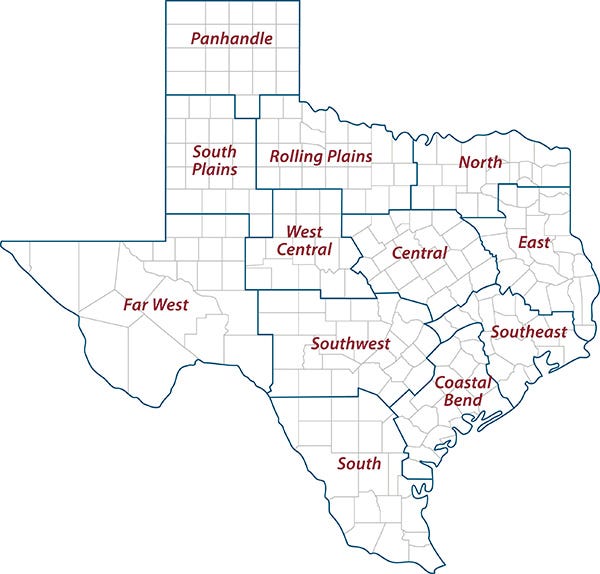
Texas rice growers faced a challenging 2019 due to early and late-season rains, according to a Texas A&M AgriLife Research expert.
Dr. Ted Wilson, Texas A&M AgriLife Research and Extension Center director, Beaumont, said reports on yields and quality are too preliminary to determine likely outcomes, but he expects a below-average year due to late plantings and late rains that included flooding in Texas’ rice-growing regions.
Yields in recent years have averaged around 8,000 pounds per acre, Wilson said.
Texas’ rice crop includes 100 percent of main crop acreage and the acres that producers decide to take to a second harvest, also known as the ratoon crop. Producer surveys indicate 64 percent of producers took their acres to ratoon, but Wilson said he expects fewer acres actually producing ratoon rice.
Wilson said the wet spring will likely contribute to lower yields this growing season. Flooding from Tropical Storm Imelda likely didn’t help remaining stands of the main crop or ratoon potential.
The effects of late plantings and Imelda are still unknown because harvest surveys from producers, which help assess yields and quality are only now coming in, Wilson said.
As of Sept. 27, around 97 percent of the main rice crop had been harvested, Wilson said. But rains from Tropical Storm Imelda delivered up to 40-plus inches of rainfall along rice-producing areas of southern Texas.
“Wet springs tend to delay planting. For every week of delay, there is a yield penalty because an increasing amount of grain is produced when there are higher nighttime temperatures, which reduces rice plant’s efficiency,” Wilson said. “Now there are questions about a good portion of the ratoon crop, especially if there was lodging due to mud.”
Delays
The majority of rice planting in Texas usually occurs by the last week of March or first week of April west of Houston and the second to third week of April east of Houston, he said. But there were reports of planting as late as June, and some producers missed their window to plant altogether.
Delays meant main crop harvest, which typically occurs beginning in July, extended into September, he said.
“Our research shows you lose 310 pounds per acre per week each week harvest is delayed due to higher nighttime temperatures chewing up plant energy,” he said. “So, if you were planting in June east of Houston, that��’s eight to nine weeks times 310 pounds per acre. Those are considerable losses.”
Wilson said individual growers did very well this year, but crop performance will likely depend on location, planting and growing conditions and any other challenges.
Other challenges
Pests were localized in Texas rice this year, but diseases like kernel smut impacted several producers, Wilson said. The fungal disease has become progressively worse over the past five to six years.
“It hurts grain, and some individual fields where kernel smut was found had loads of rice rejected by driers and mills,” he said.
Narrow brown leaf spot is another disease that is increasing in severity and is affecting yields, Wilson said. There is no highly effective treatment for brown leaf spot.
“I’m very impressed with Texas rice growers, but when you face challenges like those presented this year, it can be difficult,” he said. “Hopefully there weren’t too many losses from Imelda, and the ratooned crop does well.”

CENTRAL: The district reported hot temperatures and needed more moisture. Some brush work was done. Cattle were in fair condition. Stock tank and pond levels were decreasing. Pastures were drying out. Trees were showing stress from drought. Cotton harvest yields varied from very good to bad. Corn harvest was complete. Counties reported short to very short soil moisture. Rangeland and pasture conditions were mostly poor.
ROLLING PLAINS: Most counties reported trace amounts of rain up to 3 inches. Clay County reported up to 6 inches of rainfall in areas. Rangeland and crop conditions continued to progress. Cotton continued to mature as bolls continued to open. Wheat producers continued planting. Livestock remained in good condition.
COASTAL BEND: Scattered showers fell across the district, but some areas remained fairly dry. Fieldwork continued with remaining cotton harvest, stalk destruction, disking, plowing and some winter pastures being planted. Cotton gins were still running around the clock and were expected to continue for several more weeks. Hay baling accelerated as producers tried to get another cutting. Rangelands and pastures were improving after recent rains, but many livestock producers were still supplementing with hay or protein. Livestock were in good condition, and fall calves were hitting the ground and doing well.
EAST: Rains brought by Tropical Storm Imelda were not enough to relieve drought conditions in the district. Many counties still needed much more rain to improve pasture and meadow conditions. Producers were on hold waiting for more moisture to make another cutting of hay. Pasture and rangeland conditions were fair. Subsoil and topsoil conditions were adequate. Preparations were made for cool-season vegetable crops. Polk County reported producers were planting winter pastures and some stands of ryegrass were already established. Most other counties were on hold waiting for moisture to plant winter pastures. Livestock were in good condition. Cattle prices were higher. Wild pigs caused extensive damage to creeks, pastures and hay meadows. Houston County reported that horse flies were a tremendous problem. Armyworms continued to be an increasing problem.
SOUTH PLAINS: Heavy rains were reported across most counties, with farmers receiving 3-4 inches of rain. Other counties still needed more moisture. Heavy hail in eastern counties destroyed cotton in several fields with all the bolls and leaves being stripped from the stalk. Several pivots were damaged in the storm. Other cotton in the eastern part of the counties received lighter damage from the hailstorm. Winter wheat was emerging and making a good stand after recent rains. Late-planted corn and sorghum were harvested for silage. Producers were busy making decisions on the best defoliant to apply when fields dry up. Cattle were in good condition.
PANHANDLE: Northern parts of the district were warmer than normal and needed moisture. Early planted corn was being harvested. Silage harvest was complete. Wheat planting was progressing. Rangelands and pastures were in fair to good condition and going dormant. Most outlooks for cotton were poor. Eastern parts of the district reported cotton to be fair, and bolls were opening. Peanuts were fair. Subsoil moisture was less than adequate, and topsoil moisture was very short. Southern parts of the district reported moisture conditions were favorable for wheat and rangeland conditions. Moisture may affect cotton yields and quality for bolls open to the rain.
NORTH: Soil moisture was mainly short across the district with some counties reporting adequate levels. Many counties needed rain, but Cooke County reported some areas received 3.5 inches. Temperatures ranged from the mid- to high-90s. Soils were dry and full of cracks. Hay producers were working overtime to get the last cutting out. Armyworm reports increased with heavy infestations in some places.
FAR WEST: High temperatures were in the low-90s with lows in the low-60s. Thunderstorms brought 0.38-1.68 inches of rain. Cattle producers were rotating dry cows to fall grazing pastures and preparing for the next season. Fields were prepared and ready for wheat and oats. A small amount of wheat was planted. Cotton harvest was starting to pick up as fields already sprayed were being quickly stripped. Most harvested fields were dryland cotton. Yields were below average to very low. Irrigated cotton should be ready for harvest in coming weeks. Many cotton fields were being sprayed with defoliant. Pecans were coming along very well with earlier varieties reaching shuck split. Yields looked very good. Pastures were a little greener with a few weed issues reported. Producers continued to feed livestock and wildlife.
WEST CENTRAL: Soil moisture and pastures declined under hot, dry conditions. Wildfire potential was high, and much of the district remained under a burn ban. Field preparations for small grains continued with some producers putting seed in the ground to be ready for the next rain. Many farmers and ranchers were feeding cattle hay and protein early due to poor grazing conditions. Stocker steers and heifers sold steady. Feeder steers and heifers sold $3 higher per hundredweight. Packer cows sold $2 higher while packer bulls sold steady. Pairs and bred cows sold in good demand.
SOUTHEAST: Most of the district received rain amounts that improved conditions, but there was flooding. Lee County reported extremely hot and dry conditions. Most of Chambers County received 40-plus inches of rain from Tropical Storm Imelda. About 30% of rice was still in fields and will not be harvested. Some fields were still underwater, and conditions will be evaluated in the coming days. Pastures rebounded with the rain. Cattle were healthy, but flies continued to be an issue. Rangeland and pasture ratings were excellent to very poor with good being most common. Soil moisture levels ranged from adequate to very short with adequate being most common.
SOUTHWEST: Very little precipitation was reported with mostly hot and extremely dry conditions. Rangelands continued to be dry, and wildfire was a concern. Livestock were in fair condition, and supplemental feeding continued for livestock.
SOUTH: Northern, eastern and western parts of the district reported warm weather conditions with very short soil moisture levels. Southern areas reported mild weather with scattered showers and short to adequate soil moisture. Parts of Live Oak County reported 1-3 inches of rain. Cotton harvest was wrapping up in some areas and continued in others. Average yields were reported. Producers were busy destroying cotton stubble and plowing harvested fields. Peanuts were maturing under irrigation and approaching harvest. Fieldwork for planting small grains continued. Wheat and oat plantings were still on hold as producers waited for moisture to get fields started. Pecans were doing well. Irrigated Coastal Bermuda grass and some vegetables were doing well. Cabbage made good progress, and some spinach was planted. Rangelands and pastures continued to suffer from extremely dry conditions. Some supplemental feeding was reported. Starr County reported rangeland and pastures continued to improve.
Source: is AgriLife TODAY, which is solely responsible for the information provided and is wholly owned by the source. Informa Business Media and all its subsidiaries are not responsible for any of the content contained in this information asset.
About the Author(s)
You May Also Like




